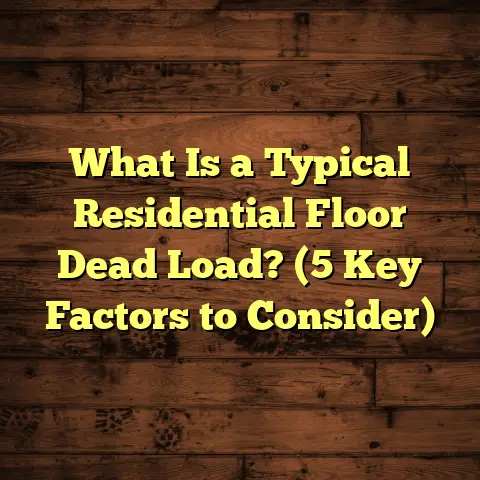What is a Porch in a Floor Plan? (5 Essential Design Tips)
I remember the first time I stepped onto a porch during a summer evening—the gentle hum of cicadas, the warm breeze brushing past me, and the soft creak of wooden boards beneath my feet. That moment felt like a pause in time, a small sanctuary just outside the front door where the world slowed down. Porches aren’t just architectural features; they shape how we experience our living spaces and neighborhoods. They offer us a place to relax, greet neighbors, or simply enjoy the changing seasons.
If you’ve ever wondered what exactly a porch is in a floor plan or how to design one that fits your lifestyle and budget, I’m here to share what I’ve learned over years of building, remodeling, and living with porches. Let’s explore everything from the basics to essential design tips that can help your porch become a true extension of your home.
What Is a Porch in a Floor Plan?
A porch is an exterior architectural feature attached to the house, typically located at the front, side, or back of the building. It serves as a transitional space between indoors and outdoors. Unlike patios or decks, porches are generally covered by a roof and sometimes partially enclosed by walls or railings. This roof provides shelter from sun and rain, making porches more versatile than other outdoor spaces.
Porches vary widely in size and style. They can be as small as a 20-square-foot entryway just big enough for a welcome mat or as large as 300 square feet—or more—designed for lounging and social gatherings. The typical porch depth ranges from about 6 to 8 feet; this is usually enough space for chairs or a small table without feeling cramped. Width can range anywhere from 10 to 20 feet or beyond depending on the architectural style and lot size.
In a floor plan, a porch is often represented as an outlined space connected directly to the home’s main entrance or living areas. It can be integral to the overall footprint of the home or added on later as an extension. Sometimes, porches wrap around corners of the house, combining front and side porches into one continuous outdoor area.
How Porches Differ From Other Outdoor Spaces
People often confuse porches with decks, patios, verandas, or stoops. Here’s how I differentiate them when discussing plans with homeowners:
- Porch: Covered with a roof, attached to the home, may have railings or partial walls.
- Deck: Usually elevated with open railings; often uncovered but can have pergolas or awnings.
- Patio: Ground-level paved space without a roof; often made of stone or concrete.
- Veranda: Larger than a porch, usually wrapping around multiple sides of the house.
- Stoop: Small platform or set of steps leading to an entrance; generally uncovered.
Porches blend indoor comfort with outdoor openness in ways decks or patios don’t always match. That shelter overhead allows for furniture placement and use throughout most seasons.
Why Porches Are More Than Just an Entry Point
When I first started working on homes, I viewed porches as purely functional—just a way to get inside dry and out of the sun. Over time though, I realized porches influence how people live. A porch can encourage neighbors to stop by for conversation or become a peaceful retreat at the end of a long day.
The psychology behind porches fascinates me. Studies show that people who spend time on their porches report higher satisfaction with their neighborhoods and feel safer because they maintain “eyes on the street.” Porches foster community interaction that’s lost in neighborhoods without them.
From a practical standpoint, porches also protect your front door and entry area from weather damage. The roof shields woodwork or paint from UV rays and moisture that cause wear over time.
The Value a Porch Adds to Your Home
Adding or upgrading a porch can increase your home’s market value significantly. The National Association of Realtors reports that an updated front porch may boost resale value by 5-10%. In some markets, that could mean thousands of dollars.
One homeowner I worked with saw their property’s appraisal jump by $15,000 after we replaced their tired stoop with a charming covered porch complete with stone flooring and railings matching their home’s style.
Beyond dollar value, porches affect curb appeal. A well-designed porch invites visitors in visually and emotionally before they even walk through the door.
Five Essential Porch Design Tips from My Experience
1. Size It Right: How Big Should Your Porch Be?
I’ve seen plenty of designs where homeowners either make the porch too small to be functional or so large it feels wasted. The right size depends on how you want to use it.
Are you planning on quick stops—like dropping off packages—or longer hangouts with friends? A porch sized for casual seating typically needs at least 6 feet in depth so chairs don’t block traffic pathways. For dining tables or swings, 8-10 feet depth is better.
Width matters too. A narrow porch (under 8 feet) often feels like a passageway rather than a place to relax. I recommend 10-12 feet minimum width to fit furniture comfortably without overcrowding.
Here’s an example from one project: A 7×14-foot porch was perfect for two rocking chairs and a small table but felt tight when we tried adding extra seating for guests. We ended up expanding it by two feet width-wise during construction.
If you have space constraints but want functionality, consider extending the porch lengthwise rather than widthwise; it can create more seating zones without obstructing access.
2. Material Choices That Stand Up to Time and Weather
Porch materials play a huge role in how long it lasts and how much upkeep it requires. I always base material recommendations on local climate conditions.
In wetter areas like the Pacific Northwest or Southeast U.S., moisture-resistant options like composite decking or pressure-treated lumber are smart because wood rot is common otherwise. Composite decking ranges between $15-$25 per square foot installed but offers low maintenance—no sanding or staining needed.
For drier climates like Arizona or Southern California, natural woods such as cedar, redwood, or cypress are popular choices. They’re beautiful and durable if properly maintained but cost roughly $8-$12 per square foot installed.
Stone and brick flooring materials add elegance and durability but tend to be pricier—$20-$35 per square foot on average—and require professional installation due to weight and complexity.
When selecting railing materials, metal options like wrought iron or aluminum last longer than wood but cost more upfront ($40-$70 per linear foot). Vinyl railings are maintenance-free but less traditional looking.
3. Roof Design: Not Just Shelter, But Style
Roof style defines your porch’s character and comfort level. I’ve worked with clients choosing between basic shed roofs (single sloped), gabled roofs (triangular peaks), or flat roofs with modern lines.
Gabled roofs are classic and echo many home styles well. They provide good drainage and allow for ceiling fans or lighting fixtures beneath them.
Shed roofs are simpler and cheaper—ideal for smaller porches or side entries.
Flat roofs work great with contemporary designs but require excellent waterproofing to avoid leaks.
Cost-wise, adding roofing can range from $3,000 for small simple structures up to $15,000+ for complex designs incorporating columns, decorative moldings, or custom materials like copper.
I once helped install a gabled roof porch on a Victorian-style home. The roof design included intricate brackets matching existing trim work—it took nearly four weeks but created stunning curb appeal that wowed visitors.
4. Lighting and Electrical: Extending Porch Usability
If you only think about your porch during daylight hours, you’re missing out on half its potential. Proper lighting transforms your porch into an inviting nighttime space.
I always suggest layering lighting: overhead fixtures combined with wall sconces for ambiance plus task lighting near seating areas.
Ceiling fans with integrated lights serve dual purposes—cooling during warm months and illumination year-round.
String lights wrapped around posts add charm but are better as accents than primary lighting because they don’t illuminate well enough for activities like reading.
Electrical installation costs vary widely depending on wiring complexity but expect $1,000-$2,500 for basic setups including outlets, switches, and fixtures on an average-size porch.
On my own porch, I installed dimmable LED sconces paired with overhead fans; this cost about $1,200 total but made summer nights comfortable and cozy for family dinners outside.
5. Comfort & Style: Furniture and Accessories
This is where personality shines through. A porch becomes truly inviting when furnished with comfortable seating—not just chairs but benches with cushions, swings, or even daybeds depending on space.
Weather-resistant fabrics like Sunbrella keep cushions looking fresh despite rain or sun fading.
Adding rugs designed specifically for outdoor use softens hard floors beneath your feet while defining seating areas visually.
Planters filled with flowers or herbs provide color, fragrance, and connection to nature right outside your door.
I recall one client who wanted their porch to feel like an outdoor living room; we sourced custom cushions in colors matching their interior palette and added built-in benches along two sides for extra seats during gatherings.
How Long Does Porch Installation Take? What To Expect
Porch installation length depends heavily on size and complexity of design:
- Small simple porches (6×8 feet) with wood framing: Usually take about 5-7 days.
- Medium porches (8×12 feet) including roofing & finishing: Around 1-2 weeks.
- Large porches (200+ sq ft) with stone flooring or complex roofing: Can take 3-5 weeks.
Weather delays happen frequently—rain can stop framing or roofing progress quickly—and permitting requirements might add days before work starts legally.
When scheduling projects for clients, I always pad timelines by at least 20% to account for unexpected issues like delivery delays of materials or site access problems.
Cost Breakdown: A Closer Look at Porch Expenses
Porch costs vary broadly depending on size, materials chosen, labor rates in your area, and features like electrical work or custom finishes.
Here are rough estimates based on recent projects covering different scenarios:
| Porch Size | Materials Cost (USD) | Labor Cost (USD) | Extras (Lighting/Fans) | Total Estimate (USD) |
|---|---|---|---|---|
| Small (6×8 ft) | $1,500 – $2,500 | $1,200 – $1,800 | $300 – $700 | $3,000 – $5,000 |
| Medium (8×12 ft) | $3,500 – $5,000 | $2,500 – $3,500 | $800 – $1,200 | $6,800 – $9,700 |
| Large (10×20 ft) | $7,000 – $12,000 | $4,500 – $7,000 | $1,000 – $2,000 | $12,500 – $21,000 |
Keep in mind prices fluctuate regionally—for example labor in urban areas tends to be higher—and some materials like exotic woods or custom stone can double estimates above averages here.
How Tools Like FloorTally Help Me Manage Porch Projects
Estimating costs accurately can be tricky when juggling various materials—wood types vs composite decking—labor rates from different subcontractors—and extras like lighting or ceiling fans.
I lean heavily on FloorTally during planning phases because it lets me input local material prices alongside current labor rates tailored by region. By adjusting variables like waste factors (usually around 5-10% extra material ordered), FloorTally spits out detailed breakdowns that help me stay realistic about budgets early on.
This tool saves me hours compared to manually calculating every line item in spreadsheets—or worse yet—guessing based on memory alone. It’s especially useful when clients want multiple design options quickly priced out so they can decide what fits their needs best without surprises later.
Real-Life Examples That Show What Works
Case Study #1: Cozy Front Porch Addition in Suburban Neighborhood
A young family wanted an inviting front porch to replace their concrete stoop. Space was limited—a narrow 7×10-foot area next to stairs leading up to their door.
We built a composite decking floor with simple white railings matching their house trim. A shed-style roof extended just enough for full coverage without blocking windows above.
Total project took 12 days including electrical wiring for two sconces plus ceiling fan installation. Final cost was roughly $6,000 including all materials and labor.
The family loves having morning coffee there now—one mother told me it’s her favorite spot to watch their kids play safely outside while she sips tea peacefully.
Case Study #2: Large Wrap-Around Porch Transforms Historic Farmhouse
An older farmhouse needed serious curb appeal upgrades while preserving historic charm. We designed a wrap-around porch measuring nearly 300 square feet covering front and side facades.
Natural stone flooring combined with cedar railings matched perfectly with original house colors. Gabled roof sections coordinated with existing rooflines enhanced architectural interest dramatically.
Due to complexity—including custom trim work and electrical outlets spaced evenly along perimeter—the project lasted five weeks and cost about $28K total including high-end materials.
The homeowners hosted several parties shortly after completion; neighbors kept complimenting how welcoming it felt compared to before when the yard was bare gravel near the entrance.
Porches in Different Climates: What You Should Know
Where you live influences nearly every aspect of porch design from materials used to layout decisions:
- Cold climates (Minnesota/New England): Fully enclosed or screened porches allow longer seasonal use; insulated roofing helps retain heat.
- Hot climates (Arizona/Texas): Wide eaves provide shade; fans help circulate air; light-colored materials reduce heat absorption.
- Humid climates (Florida/Southeast): Moisture-resistant decking prevents rot; screened porches guard against insects.
- Coastal regions (California/Carolinas): Salt-resistant metals & treated wood prevent corrosion; hurricane straps reinforce roofs against storms.
Understanding these factors early saves money by avoiding costly repairs later due to unsuitable materials failing prematurely under local conditions.
The Social Role of Porches: More Than Just Architecture
Beyond function and form lies the social power of porches that often surprises first-time builders. Porches invite interaction; they become places where neighbors chat informally across lawns or kids wait safely outside watching passersby.
I find that homes without porches miss out on these little moments that build community bonds naturally over time. Adding even modest front porches encourages casual “hello” exchanges that strengthen neighborhood ties without forcing gatherings indoors formally.
What About Enclosed Porches?
Enclosed porches—sometimes called sunrooms—add protection from weather while maintaining outdoor views. They usually have screens or glass walls instead of open railings.
These setups extend usable months especially in colder regions where open porches see limited use during winter months.
Costs rise though because you’re basically building additional heated living space requiring insulation and sometimes HVAC integration. Expect prices near $50-$100 per square foot depending on finishes chosen.
Maintenance Tips From My Porch Projects
Keeping your porch looking great requires some regular attention:
- Wood Porches: Annual cleaning plus sanding & resealing every 2-3 years prevents damage.
- Composite Decking: Usually just needs power washing once per year.
- Roofing: Check gutters & shingles twice yearly especially after storms.
- Furniture: Store cushions indoors during wet seasons; clean fabrics regularly.
- Lighting: Replace bulbs promptly; inspect wiring periodically for safety.
Proper maintenance extends lifespan dramatically saving thousands compared to early replacements due to neglect.
Final Thoughts: Bringing It All Together
Porches are more than just architectural add-ons—they’re lifestyle enhancers that blend comfort with style while connecting us to our surroundings. Whether you want a small cozy nook or large gathering spot outside your front door depends entirely on your needs and space available.
Starting with clear goals about function will guide sizing decisions. Choosing appropriate materials based on climate ensures durability while good roof design maximizes comfort year-round. Thoughtful lighting and inviting furniture complete the picture making your porch a place people want to be rather than just pass through quickly.
Accurate cost planning is essential too—tools like FloorTally help me take guesswork out of budgeting so projects run smoothly without financial surprises later.
If you’re considering adding a porch or upgrading an existing one, remember it’s an investment not just in your home’s value but in daily experiences that matter most—relaxation after work, spontaneous neighbor chats, family mornings sipping coffee together under a shaded roof.
So go ahead—step outside your door into comfort crafted just for you!





